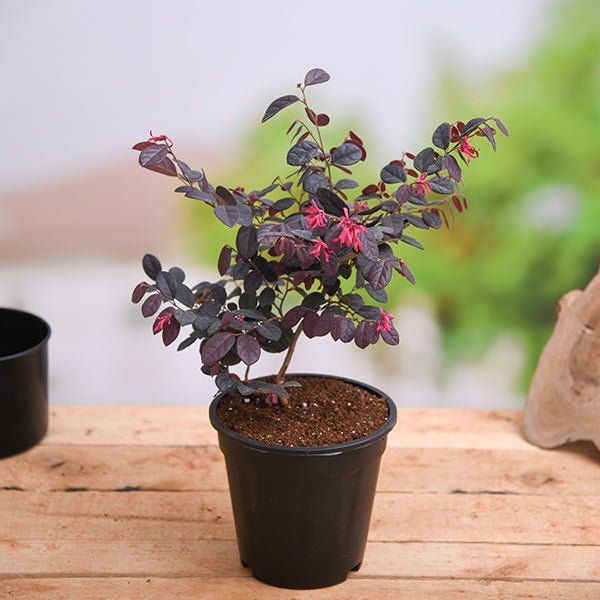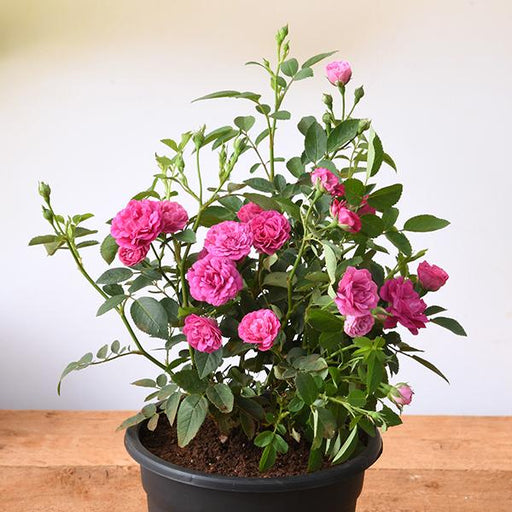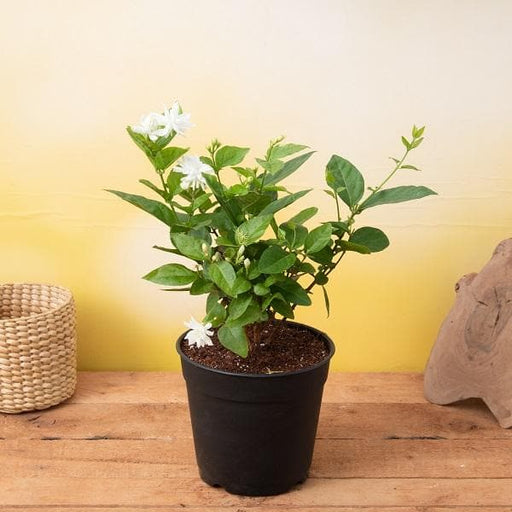
Loropetalum, Chinese Fringe Bush - Plant
(MRP Inclusive of all taxes)
- Shipping ₹79 for entire order
- Dispatch in 7 days
- Country of origin: India

(MRP Inclusive of all taxes)
 Save 29%
Save 29%
Air Purifier Money Plant with Pot The Air Purifier Money Plant, also known as Pothos or Epipremnum aureum, is a stunning indoor plant that...
View full details
 Save up to 15%
Save up to 15%
Peace Lily, Spathiphyllum - Plant The Peace Lily, scientifically known as Spathiphyllum, is a stunning houseplant celebrated for its elegant white...
View full details
 Save 25%
Save 25%
Jasminum sambac, Mogra, Arabian Jasmine - Plant Jasminum sambac, commonly known as Mogra or Arabian Jasmine, is a fragrant flowering plant...
View full details
 Save 18%
Save 18%
Combo Constituents Includes the Parijat Tree (Night-Flowering Jasmine), a culturally significant plant with fragrant flowers. Description The Pari...
View full details
 Save 25%
Save 25%
Miniature Rose, Button Rose (Any Color) - Plant The Miniature Rose, also known as the Button Rose, is a charming and compact flowering plant that ...
View full details Save 25%
Save 25%
Damascus Rose, Scented Rose (Any Color) - Plant The Damascus Rose, also known as Rosa damascena, is a timeless symbol of beauty and romanc...
View full details
 Save 17%
Save 17%
Beautiful Fragrant Mogra, Arabian Jasmine Plant with Pot The Beautiful Fragrant Mogra, also known as Arabian Jasmine (Jasminum sambac), is...
View full details Save 15%
Save 15%
Pack of Vermicompost and Neem Cake for House Plants Transform your indoor garden with our premium Pack of Vermicompost and Neem Cake, spec...
View full details
Pack of Plant Growth and Flower Boosters Unlock the full potential of your garden with our Pack of Plant Growth and Flower Boosters! This ...
View full details Save 38%
Save 38%
Combo of Jeevamrut and Neem Raksha for Easy Growth and Protection of Houseplants Transform your indoor garden with our exclusive combo of ...
View full details Save 22%
Save 22%
Plant Nutrients Kit (Pack of 16) for a Healthy Garden Transform your garden into a lush paradise with our Plant Nutrients Kit, featuring 1...
View full details Save 16%
Save 16%
Combo of Top Plant Fertilizers Elevate your gardening game with our exclusive Combo of Top Plant Fertilizers, featuring two bags of premiu...
View full details Save 24%
Save 24%
Pack of 4 Additives to Make Soil Healthy and Nutrient Rich Transform your garden into a thriving ecosystem with our Pack of 4 Additives de...
View full details Save 30%
Save 30%
Transform your gardening experience with our premium Combo of Perlite and Vermiculite. This unique blend is designed to enhance soil aeration and ...
View full details Save 27%
Save 27%
Combo of 2 Vermicompost and Cocopeat - Enrich Your Soil Naturally! Transform your garden into a thriving ecosystem with our Combo of 2 Ver...
View full details
 Save 35%
Save 35%
Best 6 Plants for Perfect Indoor Garden Transform your living space into a lush oasis with our curated collection of the Best 6 Plants for a...
View full details
 Save up to 50%
Save up to 50%
Mini Succulent Garden Pack Transform your space with our Mini Succulent Garden Pack, featuring a delightful collection of 4 any variety beautiful s...
View full details
 Save 30%
Save 30%
5 Best Fragrant Plants Transform your garden or indoor space into a fragrant paradise with our curated selection of the 5 Best Fragrant Plants. Th...
View full details
 Save 24%
Save 24%
Set of 2 Bonsai Looking Grafted Adeniums Transform your indoor or outdoor space with our exquisite Set of 2 Bonsai Looking Grafted Adenium...
View full details Save 45%
Save 45%
Top 4 Die Hard Succulents Pack Transform your indoor or outdoor space with our Top 4 Die Hard Succulents Pack, featuring a curated selecti...
View full details
 Save 30%
Save 30%
5 Best Indoor Plants Pack Transform your living space into a lush oasis with our '5 Best Indoor Plants Pack.' This carefully curated collection fe...
View full details
 Save 25%
Save 25%
Set of 4 Evergreen Air Purifier Plant Pack Transform your indoor space into a lush, green oasis with our Set of 4 Evergreen Air Purifier Pla...
View full details| SrNo | Item Name | Qty |
|---|---|---|
| 1 | Loropetalum, Chinese Fringe Bush Plant in 5 inch (13 cm) Pot | 1 |
The Loropetalum, commonly known as the Chinese Fringe Bush, is a stunning evergreen shrub that adds vibrant color and texture to any garden. With its unique, fringed flowers that bloom in shades of pink, purple, and white, this plant is a favorite among gardeners and landscapers alike. Native to China and Japan, Loropetalum thrives in a variety of climates, making it a versatile choice for both residential and commercial landscapes.
What makes the Loropetalum special is its ability to maintain its beauty year-round. The foliage ranges from deep green to rich burgundy, providing a striking contrast to its colorful blooms. This hardy shrub is not only visually appealing but also attracts pollinators, contributing positively to the local ecosystem.
One of the standout features of the Loropetalum is its adaptability. It can be pruned to maintain a compact shape or allowed to grow naturally, making it suitable for hedges, borders, or as a standalone specimen. Its resilience to drought and pests further enhances its appeal for low-maintenance gardening.
The Loropetalum plays a significant role in supporting local wildlife, particularly pollinators. By planting this shrub, you contribute to biodiversity and help create a sustainable environment. Its drought-resistant nature also means it requires less water, making it an eco-friendly choice for gardeners looking to conserve resources.
When it comes to Loropetalum, variety is the spice of life! From the deep purple foliage of 'Purple Pixie' to the vibrant pink blooms of 'Ruby', these plants are like a colorful party in your garden. Each variety has its own personality, making it easy to find the perfect match for your landscape. Whether you want a compact shrub or a sprawling beauty, Loropetalum has got you covered. Just remember, with great variety comes great responsibility—choose wisely!
Loropetalum thrives in well-drained soil and loves a sunny spot, but it’s not too picky. Think of it as the Goldilocks of plants—too much shade? Nope! Too much water? No thanks! Just the right amount of sun and moisture, and it’ll reward you with stunning foliage and blooms. So, if you’re looking for a low-maintenance diva, this plant is your go-to!
Pruning Loropetalum is like giving your plant a stylish haircut. A little snip here and there can enhance its natural beauty and keep it looking fabulous. The best time to prune is in late winter or early spring before the new growth starts. Just remember, don’t go overboard—this isn’t a buzz cut! A light trim will encourage bushier growth and more blooms, making your Loropetalum the talk of the garden.
While Loropetalum is generally a tough cookie, it’s not immune to the occasional pest party. Aphids and spider mites might try to crash the bash, but with a little vigilance and some organic insecticidal soap, you can send them packing. And don’t forget about root rot—overwatering is the ultimate party pooper. Keep an eye on your plant, and it’ll stay healthy and happy!
Pairing Loropetalum with the right companions can elevate your garden game. Think of it as a plant power couple! Combine it with evergreens for a year-round show or mix it with perennials for a splash of color. The contrast of textures and colors will make your garden look like it’s ready for a magazine cover. Just make sure your companions have similar watering needs, or you might end up with a plant drama!
Incorporating Loropetalum into your landscape design is like adding a splash of paint to a blank canvas. Its vibrant colors and unique shape can serve as a focal point or a lovely backdrop. Use it as a hedge, in mixed borders, or even as a standalone specimen. The possibilities are endless! Just remember to consider its mature size so it doesn’t outgrow its welcome.
Loropetalum is the gift that keeps on giving throughout the seasons. In spring, it bursts into bloom with delicate, fringe-like flowers that are sure to turn heads. Summer brings lush foliage, while fall showcases stunning color changes. Even in winter, its structure adds interest to the landscape. It’s like having a year-round garden party, and everyone’s invited!
Loropetalum prefers slightly acidic to neutral soil, but it’s not a soil snob. It’s like that friend who can adapt to any situation—just give it well-drained soil, and it’ll thrive. If your soil is heavy clay, consider amending it with organic matter to improve drainage. A happy plant is a healthy plant, and healthy plants are the life of the garden!
Watering Loropetalum is a delicate dance. Too much, and you risk root rot; too little, and it’ll be parched. Aim for a consistent moisture level, especially during the hot summer months. A good rule of thumb is to water when the top inch of soil feels dry. Think of it as giving your plant a refreshing drink—just don’t drown it!
Fertilizing Loropetalum is like giving it a little boost of energy. A balanced, slow-release fertilizer in spring will keep your plant happy and healthy. Just remember, moderation is key! Over-fertilizing can lead to excessive growth and fewer blooms. So, treat your Loropetalum to a little nourishment, and watch it flourish like the superstar it is!
Want to multiply your Loropetalum? Propagation is the way to go! You can take softwood cuttings in late spring or early summer and watch them root like magic. Just make sure to keep them moist and in a warm spot. It’s like cloning your favorite plant—who wouldn’t want more of that fabulousness in their garden?
This delightful shrub, also known as Chinese fringe flower, boasts vibrant purple or pink foliage and whimsical fringe-like flowers. It's like nature's confetti, adding a pop of color to your garden. Plus, it’s low-maintenance, making it the perfect plant for those who want beauty without the fuss.
Caring for this beauty is a breeze! Plant it in well-drained soil and give it a sunny spot. Water it regularly, but don’t drown it—this isn’t a swimming pool party! Prune it occasionally to maintain its shape, and watch it thrive like the diva it is.
Loropetalum loves a sunny disposition, thriving in full sun to partial shade. It prefers well-drained, acidic to neutral soil. Think of it as a diva who demands the right stage—too much shade or soggy soil, and it might just throw a tantrum!
Absolutely! Loropetalum is a fabulous container plant, adding flair to patios and balconies. Just ensure the pot has drainage holes, and use quality potting soil. It’s like giving your plant a stylish apartment—just the right amount of space to thrive!
Yes, indeed! Loropetalum is not on the deer’s gourmet menu, making it a smart choice for gardens in deer-prone areas. While they might nibble on other plants, this fringe bush stands strong, like a bouncer at an exclusive club.
Loropetalum is a speedy grower, typically reaching 3 to 10 feet tall, depending on the variety. It’s like the overachiever of the plant world, filling your garden with lushness in no time. Just give it the right conditions, and it’ll be off to the races!
While Loropetalum is generally pest-resistant, it can occasionally attract aphids or spider mites. Think of them as uninvited guests at a party. A gentle spray of water or insecticidal soap can send them packing, ensuring your plant remains the star of the show!
Loropetalum is a bit of a diva when it comes to cold. It can handle mild winters but may struggle in harsh conditions. If you live in a chilly zone, consider providing some winter protection, like a cozy mulch blanket. After all, even plants deserve a little pampering!
Propagating Loropetalum is like sharing the love! You can take softwood cuttings in late spring or early summer. Dip them in rooting hormone, plant them in moist soil, and keep them warm. With a little patience, you’ll have new plants ready to strut their stuff in no time!
Loropetalum flowers are like a painter’s palette, typically blooming in shades of pink, purple, or white. The vibrant colors can brighten any garden, making it a favorite among plant enthusiasts. It’s like having a floral fashion show right in your backyard!
Absolutely! Loropetalum is a landscaping superstar, perfect for borders, hedges, or as a focal point. Its unique foliage and flowers add texture and color, making your garden the talk of the neighborhood. It’s like the celebrity of the plant world—everyone wants a piece of it!